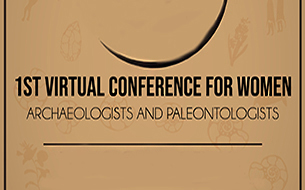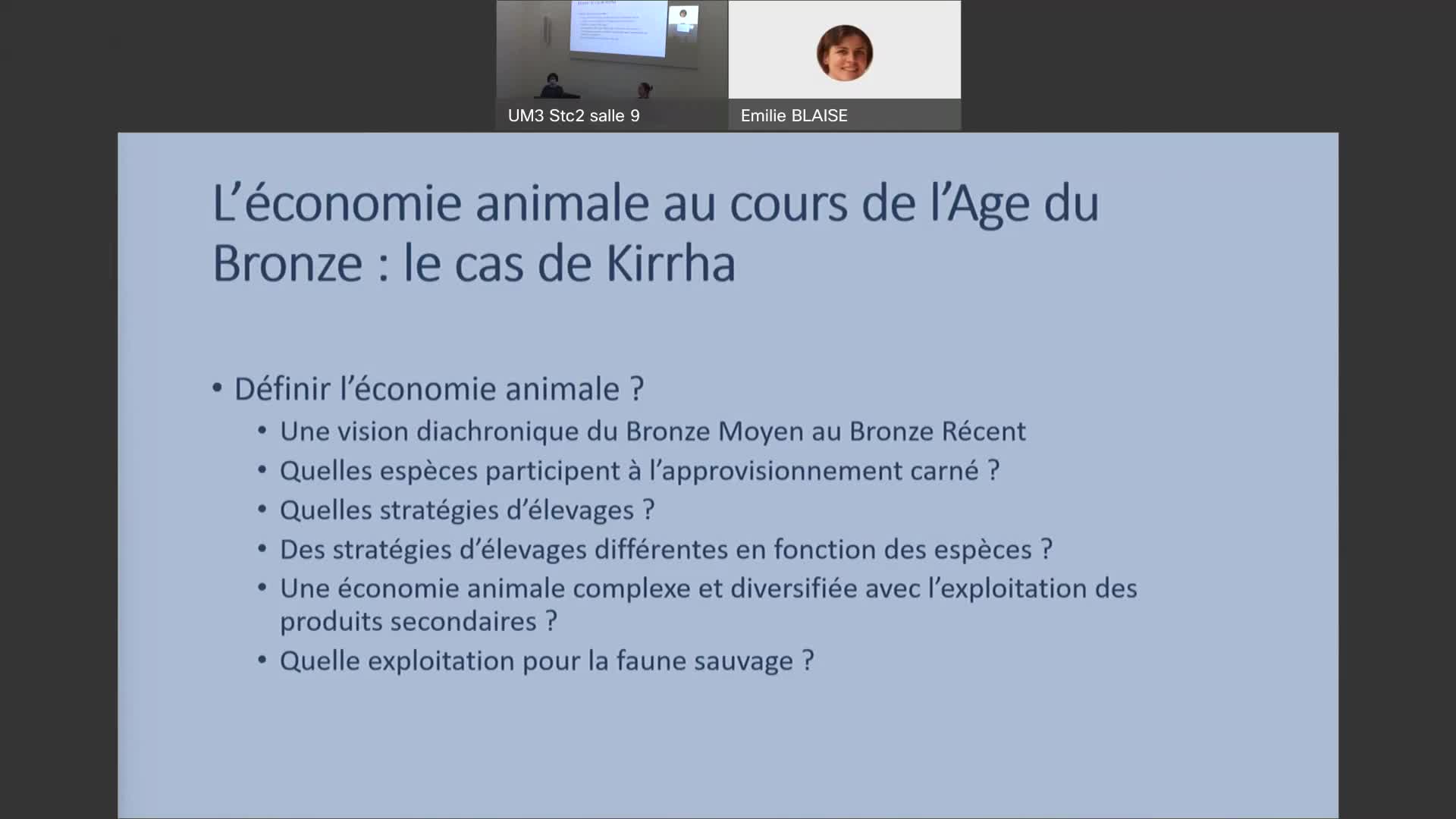Notice
New sperm whale cranium from the late Miocene and a revised family attribution for the small crown physeteroid "Thalassocetus" / Apolline Alfsen
- document 1 document 2 document 3
- niveau 1 niveau 2 niveau 3
Descriptif
New sperm whale cranium from the late Miocene and a revised family attribution for the small crown physeteroid Thalassocetus / Apolline Alfsen, in colloque "1st Virtual Conference for Women Archaeologists and Paleontologists. Nouveaux apports à l’étude des populations et environnements passés" organisé par le laboratoire Travaux et Recherches Archéologiques sur les Cultures, les Espaces et les Sociétés (TRACES) de l’Université Toulouse Jean Jaurès et le laboratoire Paléontologie Évolution Paléoécosystèmes (PALEVOPRIM) de l'Université de Poitiers, sous la responsabilité scientifique de Julie Bachellerie, Ana Belén Galán López (Traces), Émilie Berlioz et Margot Louail (Palevoprim). Université Toulouse Jean Jaurès, 8-9 mars 2021. Session 1 : Morphological variability, taxonomy and adaptations.
Among cetaceans, toothed whales (Odontoceti) are known to display a unique arrangement in their skull that has been linked to their echolocation abilities. Their nasal and facial regions lack of symmetry and some of their right-sided bones (maxilla, premaxilla) impressively spread onto the left side. Despite the continuously improving fossil record, our understanding of the origin and early radiation of the two modern sperm whale families Kogiidae (incl. the pygmy and dwarf sperm whales Kogia spp.) and Physeteridae (incl. the great sperm whale Physeter) remains limited. The discovery of a new physeteroid cranium from the late Miocene (Tortonian) of Antwerp (Belgium) shed new light on the poorly resolved phylogeny. Among extinct species, based on cranial material from the late early to middle Miocene of Antwerp, the small-sized Thalassocetus antwerpiensis has been recognized as the earliest branching kogiid. The new specimen leads to the description and comparison of a close relative of T. antwerpiensis. Thanks to the relatively young ontogenetic stage of this new cranium, the highly modified plate-like bones making the floor of its facial region could be individually removed, a fact that greatly helped deciphering their identity and geometry. Close morphological similarities with T. antwerpiensis allow the reassessment of several facial structures in the latter; notably the reinterpretation of a crest-like structure, previously identified as a sagittal facial crest, typical for kogiids, and here revised as theleft nasal (lost in known kogiids) and the left maxilla. Implemented in a phylogenetic analysis, the new anatomical interpretations result in the new Belgian specimen and T. antwerpiensis being recovered as sister-groups in the Physeteridae. Consequently, the geologically oldest kogiids are now dated from the Tortonian, further extending the ghost lineage separating these early late Miocene kogiid records from the estimated latest Oligocene to earliest Miocene divergence of kogiids and physeterids.
Thème
Documentation
Références documentaires
Bianucci G. & Landini W., 2006. Killer sperm whale: a new basal physeteroid (Mammalia, Cetacea) from the Late Miocene of Italy, Zoological Journal of the Linnean Society, 148: 103–131. [En ligne : https://academic.oup.com/zoolinnean/article/148/1/103/2630818].
Collareta A., Lambert O., Muizon C. de, Urbina M., & Bianucci G., 2017. Koristocetus pescei gen. et sp. nov., a diminutive sperm whale (Cetacea: Odontoceti: Kogiidae) from the late Miocene of Peru, Fossil Record, 20: 259–278. [En ligne : https://sciencepress.mnhn.fr/fr/periodiques/comptes-rendus-palevol/19/5].
Gol’din P. E., & Marareskul V.A., 2013. Miocene Toothed Whales (Cetacea, Odontoceti) from the Dniester Valley: The First Record of Sperm Whales (Physeteroidea) from The Eastern Europe, Vestnik Zoologii, 47: 21–26. [En ligne : http://dspace.nbuv.gov.ua/bitstream/handle/123456789/109834/03-Goldin.pdf?sequence=1].
Lambert O., 2008. Sperm whales from the Miocene of the North Sea: a re-appraisal, Bulletin de l’Institut royal des Sciences naturelles de Belgique, Sciences de la Terre, 78: 277–316. [En ligne : https://www.researchgate.net/publication/286500180_Sperm_whales_from_the_Miocene_of_the_North_Sea_A_re-appraisal].
Würsig B. G., Thewissen J. G. M. & Kovacs K. M. (eds), 2018. Encyclopedia of marine mammals. London, Elsevier, Academic Press, 1157 p. [Troisième édition].
Liens
Programme du colloque "1st Virtual Conference for Women Archaeologists and Paleontologists" (8-9 mars 2021)
Website du Laboratoire Paléontologie Évolution Paléoécosystèmes Paléoprimatologie (PALEVOPRIM)
Livret des résumés des communications du colloque "1st Virtual Conference for Women Archaeologists and Paleontologists. Nouveaux apports à l’étude des populations et environnements passés" (8-9 mars 2021)
Site internet dédié au colloque "1st Virtual Conference for Women Archaeologists and Paleontologists" (8-9 mars 2021)
Dans la même collection
-
Sensivity analysis to morphological changes of the shoulder joint: application to percussio…
Blasi-ToccacceliAliciaSensivity analysis to morphological changes of the shoulder joint: application to percussion gestures during Oldowan debitage / Alicia Blasi-Toccacceli, in colloque "1st Virtual Conference for
-
"Ouranopithecus macedoniensis" (late Miocene, Greece): analysis of mandibular fragments using …
IoannidouMelaniaOuranopithecus macedoniensis (late Miocene, Greece): analysis of mandibular fragments using 3D geometric morphometrics / Melania Ioannidou, in colloque "1st Virtual Conference for Women
-
Comminution capabilities of extant and fossil anthropoids during molar intercuspation: a preliminar…
WalkerAxelle E. C.Comminution capabilities of extant and fossil anthropoids during molar intercuspation: a preliminary experiment using a chewing simulator / Axelle E. C. Walker, in colloque "1st Virtual Conference for
-
What is shaping the brain? A perspective on brain size evolution in carnivorans / Margot…
MichaudMargotWhat is shaping the brain? A perspective on brain size evolution in carnivorans / Margot Michaud, in colloque "1st Virtual Conference for Women Archaeologists and Paleontologists. Nouveaux
-
Postnatal shape changes in the rodent mandible at a macroevolutionary scale / Morgane Dubied
DubiedMorganePostnatal shape changes in the rodent mandible at a macroevolutionary scale / Morgane Dubied, in colloque "1st Virtual Conference for Women Archaeologists and Paleontologists. Nouveaux apports à l
-
Cranial vault healing in modern humans: input of archaeological and clinical data / Aliéno…
LepetitAliénorCranial vault healing in modern humans: input of archaeological and clinical data / Aliénor Lepetit, in colloque "1st Virtual Conference for Women Archaeologists and Paleontologists. Nouveaux
-
A transdisciplinary approach to reconstruct the Nilotic socio-ecosystem in Luxor west bank during t…
NicatoreGiuliaA transdisciplinary approach to reconstruct the Nilotic socio-ecosystem in Luxor west bank during the Ptolemaic period (3rd-1st centuries BC.) / Giulia Nicatore, in colloque "1st Virtual Conference
-
Tracing Human Ancestral Migration from its Symbiotic Bacteria / Alexia Nguyen Trung
Nguyen TrungAlexiaTracing Human Ancestral Migration from its Symbiotic Bacteria / Alexia Nguyen Trung, in colloque "1st Virtual Conference for Women Archaeologists and Paleontologists. Nouveaux apports à l’étude des
-
From monoliths to megaliths: a new approach on the megalithic burials of southwestern France / Bosc…
BoscusSarahFrom monoliths to megaliths: a new approach on the megalithic burials of southwestern France / Boscus Sarah, in colloque "1st Virtual Conference for Women Archaeologists and Paleontologists. Nouveaux
-
Foragers and their symbolic landscape. Understanding the role of rock art in the territoriality of …
JobardLéaForagers and their symbolic landscape. Understanding the role of rock art in the territoriality of Later Stone Age Matobo populations / Léa Jobard, in colloque "1st Virtual Conference for Women
-
Towards a tracking of past bird seasonal migrations through geological times: what could isotopes t…
DuhamelAnaïsTowards a tracking of past bird seasonal migrations through geological times: what could isotopes tell us? / Anaïs Duhamel, in colloque "1st Virtual Conference for Women Archaeologists and
-
Study of human group behaviors during the Last Glacial Maximum in the east Carpathian area from zoo…
DemayLaëtitiaStudy of human group behaviors during the Last Glacial Maximum in the east Carpathian area from zooarchaeological remains / Laëticia Demay, in colloque "1st Virtual Conference for Women Archaeologists
Sur le même thème
-
Alimentation et élevage en Grèce centrale à l’âge du Bronze. Le cas de Kirrha
OrgeoletRaphaëlAniMed, 24 février 2022 - Raphaël ORGEOLET (MCF, CCJ Aix-en-Provence) et Marion SIRITO-OLIVIER (doctorante UPV-Montpellier 3, archéozoologue, UMR 5140 ASM)
-
-
Sylvain Foucras - « L’énigme des sépultures de chevaux au pied de Gergovie »
L'archéozoologue Sylvain Foucras, auteur de l'ouvrage, Sépultures de chevaux devant Gergovie. Archéozoologie des rituels gaulois, aux Presses universitaires Blaise Pascal, a inauguré le cycle de
-
"Ouranopithecus macedoniensis" (late Miocene, Greece): analysis of mandibular fragments using …
IoannidouMelaniaOuranopithecus macedoniensis (late Miocene, Greece): analysis of mandibular fragments using 3D geometric morphometrics / Melania Ioannidou, in colloque "1st Virtual Conference for Women
-
Comminution capabilities of extant and fossil anthropoids during molar intercuspation: a preliminar…
WalkerAxelle E. C.Comminution capabilities of extant and fossil anthropoids during molar intercuspation: a preliminary experiment using a chewing simulator / Axelle E. C. Walker, in colloque "1st Virtual Conference for
-
What is shaping the brain? A perspective on brain size evolution in carnivorans / Margot…
MichaudMargotWhat is shaping the brain? A perspective on brain size evolution in carnivorans / Margot Michaud, in colloque "1st Virtual Conference for Women Archaeologists and Paleontologists. Nouveaux
-
Postnatal shape changes in the rodent mandible at a macroevolutionary scale / Morgane Dubied
DubiedMorganePostnatal shape changes in the rodent mandible at a macroevolutionary scale / Morgane Dubied, in colloque "1st Virtual Conference for Women Archaeologists and Paleontologists. Nouveaux apports à l
-
Towards a tracking of past bird seasonal migrations through geological times: what could isotopes t…
DuhamelAnaïsTowards a tracking of past bird seasonal migrations through geological times: what could isotopes tell us? / Anaïs Duhamel, in colloque "1st Virtual Conference for Women Archaeologists and
-
New insights into the study of past populations: archeozoology and cementochronology in the Middle …
RousselAudreyNew insights into the study of past populations: archeozoology and cementochronology in the Middle Palaeolithic / Audrey Roussel, in colloque "1st Virtual Conference for Women Archaeologists and
-
Neanderthal facing climatic disruptions of the MIS 4 in southwestern France: between cynegetic choi…
DancetteChristelleNeanderthal facing climatic disruptions of the MIS 4 in southwestern France: between cynegetic choices and environmental constraints / Christelle Dancette, in colloque "1st Virtual Conference for
-
Retouched bone tools: which place in Neanderthal technical systems? / Emma Bernard
BernardEmmaRetouched bone tools: which place in Neanderthal technical systems? / Emma Bernard, in colloque "1st Virtual Conference for Women Archaeologists and Paleontologists. Nouveaux apports à l’étude des
-
Revising the microvertebrates from the Palaeolithic site of Kalamakia (Mani Peninsula), Greece / Ko…
KolendrianouMariaRevising the microvertebrates from the Palaeolithic site of Kalamakia (Mani Peninsula), Greece / Kolendrianou Maria, in colloque "1st Virtual Conference for Women Archaeologists and Paleontologists.



















